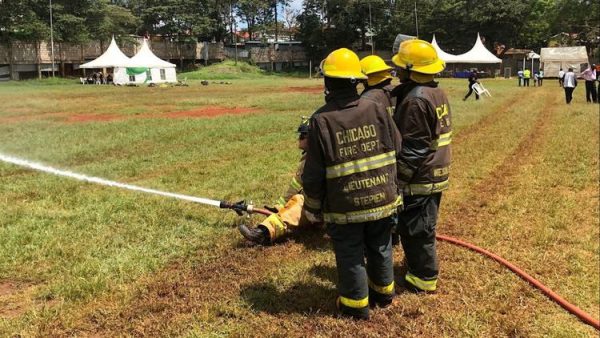Excerpts from the ChicagoTribune.com:
Many firefighters in and around Nairobi, Kenya, wear equipment labeled for the Chicago Fire Department. Hank Clemmensen and 13 other retired and active firefighters from throughout the United States returned Dec. 13 from a two-week trip to Kenya, where they hosted an annual training seminar attended by more than 250 firefighters as part of the nonprofit organization Africa Fire Mission.
Planning documents list Clemmensen as a speaker on leadership for about 25 chiefs from nearby brigades who listened on such topics as interacting with politicians and community stakeholders.
David Moore Jr., executive director and founder of Africa Fire Mission, retired from the Glendale Fire Department in Ohio and met Clemmensen who was a board member with the International Association of Fire Chiefs, a job that made him an ideal recruit due to his national connections and vast experience in dealing with industry issues, Moore said.
Moore started the nonprofit after seeing the living conditions while he was on a trip to Africa as part of Mission of Hope International. He said Africa Fire Mission now has about 30 regularly active participants, and has decided to focus on training due to the $20,000 cost of shipping the used equipment to Africa.
“What often happens with a lot of donations, generally speaking, to third world countries is they end up sitting in storage somewhere because nobody ever teaches the recipients how to use the stuff, especially when the user manuals and labels are all in another language,” Clemmensen said.
Moore credited Clemmensen and Lt. Brooks Watson of the Chicago Fire Department for the recent donation of equipment, adding that fire departments in the U.S. require extensive paperwork and assurances that their donated items are leaving the country since regulations prevent their use after a decade of service.
For the longest time, there was only one fire truck in the Nairobi area and it was based at the airport because the Kenyan federal government wanted to reassure international travelers, and many of the embassies and bigger corporations had their own private fire response teams.
The most vulnerable people are the one million residents of five “slums,” Clemmensen said, where small dwellings are built from scrap material.

Some participants in Africa Fire Mission’s December training near Nairobi, Kenya, wore protective gear donated by the Chicago Fire Department. (Africa Fire Mission photo)






























#1 by Bmurphy on January 6, 2019 - 10:19 AM
That is not correct. There are more government stations and many large commercial facilities, foreign corporate operations and private business complexes maintain their own fire brigades or subcontract protection (including EMS) to private fire/security firms.
The airport fire service also meets international ARFF standards (there is most certainly more than one fire truck at the airport!). Otherwise few, if any, foreign or even Kenyan air carriers would operate there.
Overall, however, the municipal fire service, as well as existing fire and building codes of Nairobi and Kenyan as a whole are extremely under-funded, under-staffed, and far, far behind what we take for granted in the US and other ‘first world’ areas. That’s why private businesses and other entities, both foreign and domestic, typically have to or want to provide their own protection. It’s this way in many places, such as Mexico, much of Africa, parts of India and other spots too.
Larger complexes or facilities (manufacturing, petro-chemical, transportation hubs and airports too) have full-service and even multi-station fire brigades that are much better staffed and equipped than the local services, on par with the best municipal services found in North America or Europe. Smaller facilities of the same type will usually have beefed-up built-in fire protection (large water storage tanks, full sprinkler and standpipe/hose systems, alarms, special suppression systems, fire resistive construction) and a fire brigade of cross-trained regular employees with every resource except a fire engine. Many international hotels have this setup.
A typical municipal fire service example in non ‘first-world’ areas can be found in Guadalajara, Mexico. It’s a growing international city of almost 4 million, with a rapidly expanding number of high-tech, financial and manufacturing facilities. Municipal fire protection is provided by 5 fire stations. There a very few fire hydrants, with nearly all fire fighting done via tankers. Compare that to Chicago or LA….
The municipal firefighters make it happen with the meager resources they are given by the government (sound familiar?), using donations from the US, Canada, Japan, China and Europe to fill the gaps when possible (including training provided by volunteers from the same).
The article was probably actually about a suburban area outside of Nairobi (my guess anyway). Many of these areas have NO fire service at all. There is a push worldwide in a lot of these areas to establish fire brigades, and perhaps this is the real story of this article.
#2 by John on January 4, 2019 - 8:26 PM
One fire truck in Nairobi? Nairobi’s not exactly a small city